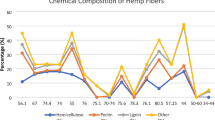Abstract
To explore the behavior of radiolytically produced hydrogen release from the waste resin stored in a high integrated container (HIC), and the mechanism of hydrogen diffusion in a near-surface disposal facility, both experimental studies and numerical simulations were performed through an accelerated irradiation test and simulated disposal, respectively. Results indicated that, 100 years after disposal, the highest hydrogen concentration appeared in the cell where the HICs were placed. The volume fraction for different scenarios postulated in the numerical simulation was 2.64% for Scenario 1, 2.28% for Scenario 2, and 3.965% for Scenario 3, all of which are lower than the hydrogen explosion limit of 4.1%. The results indicated that the simulated HIC disposal scheme is safe.





Similar content being viewed by others
References
K.J. Swyler, C.J. Dodge, R. Dayal, Irradiation effects on the storage and disposal of radwaste containing organic ion-exchange media. Report NUREG/CR-3383: United States Nuclear Regulatory Commission (1983). https://doi.org/10.2172/5088342
O. Debré, B. Nsouli, J.P. Thomas et al., Irradiation-induced modifications of polymers found in nuclear waste embedding processes Part II: the ion-exchange resin. Nucl. Instrum. Methods B 131, 321–328 (1997). https://doi.org/10.1016/s0168-583x(97)00337-6
A. Traboulsi, N. Dupuy, C. Rebufa et al., Investigation of gamma radiation effect on the anion exchange resin Amberlite IRA-400 in hydroxide form by FTIR and 13C NMR spectroscopy. Anal. Chim. Acta 717, 110–121 (2012). https://doi.org/10.1016/j.aca.2011.12.046
M.T. Ahmed, P.G. Clay, G.R. Hall, Radiation-induced decomposition of ion exchange resins: part II. The mechanism of the deamination of anion-exchange resins. J. Chem. Soc. B (1966). https://doi.org/10.1039/j29660001155
G.R. Hall, M. Streat, Radiation-induced decomposition of ion exchange resins: part I. Anion-exchange resins. J. Chem. Soc. 37, 5205–5211 (1963). https://doi.org/10.1039/jr9630005205
L.L. Smith, H.J. Groh, The effect of Gamma radiation on ion exchange resins. Report DP-549: Department of Energy and Environment (1961). https://doi.org/10.2172/4050930
A. Traboulsi, V. Labed, V. Dauvois et al., Gamma radiation effect on gas production in anion exchange resins. Nucl. Instrum. Methods B 312, 7–14 (2013). https://doi.org/10.1016/j.nimb.2013.06.021
A. Baidak, J.A. Laverne, Radiation-induced decomposition of anion exchange resins. J. Nucl. Mater. 407, 211–219 (2010). https://doi.org/10.1016/j.jnucmat.2010.10.025
L. Zhao, G. Yu, X.Y. Zhang et al., Diffusivity of hydrogen in steels at low temperatures. Corros. Sci. Prot. Technol. 17, 349–351 (2005). https://doi.org/10.3969/j.issn.1002-6495.2005.05.015. (in Chinese)
X.L. Zhen, W.B. Kan, H.L. Pan, Study on hydrogen diffusion in 304 stainless steel. Corros. Prot. Petrochem. Ind. 27, 15–16 (2010). https://doi.org/10.3969/j.issn.1007-015X.2010.04.005. (in Chinese)
T. Sullivan, Waste container and waste package performance modeling to support safety assessment of low and intermediate-level radioactive waste disposal. Technical Report BNL-74700-2005-IR: DOE/IAEA (US) (2004). https://doi.org/10.2172/15016583
H.Y. Jin, Estimating diffusion coefficients of gases by use of computer simulation. Comput. Appl. Chem. 29, 1294–1298 (2012). https://doi.org/10.3969/j.issn.1001-4160.2012.11.004
C. Boher, F. Frizon, S. Lorente et al., Influence of the pore network on hydrogen diffusion through blended cement pastes. Cem. Concr. Compos. 37, 30–36 (2013). https://doi.org/10.1016/j.cemconcomp.2012.12.009
H.T. Vu, F. Frizon, S. Lorente, Architecture for gas transport through cementitious materials. J. Phys. D Appl. Phys. 42, 105501 (2009). https://doi.org/10.1088/0022-3727/42/10/105501
J. Sercombe, R. Vidal, C. Gallé et al., Experimental study of gas diffusion in cement paste. Cem. Concr. Res. 37, 579–588 (2007). https://doi.org/10.1016/j.cemconres.2006.12.003
D.T. Niu, L.T. Chen, C.H. Zhang, Calculating model for gas diffusivity in concrete. J. Xi’an Univ. Archit. Technol. 39(6), 741–745 (2007). https://doi.org/10.3969/j.issn.1006-7930.2007.06.001. (in Chinese)
Y.J. Tang, X.B. Zuo, G.J. Yin, Gas diffusion model in concrete based on pore structural parameters. J. Build. Mater. 18, 976–981 (2015). https://doi.org/10.3969/j.issn.1007-9629.2015.06.011. (in Chinese)
F. Bardelli, C. Mondelli, M. Didier et al., Hydrogen uptake and diffusion in Callovo-Oxfordian clay rock for nuclear waste disposal technology. Appl. Geochem. 49, 168–177 (2014). https://doi.org/10.1016/j.apgeochem.2014.06.019
C. Mondelli, F. Bardelli, J.G. Vitillo et al., Hydrogen adsorption and diffusion in synthetic Na- montmorillonites at high pressures and temperature. Int. J. Hydrogen Energy 40(6), 2698–2709 (2015). https://doi.org/10.1016/j.ijhydene.2014.12.038
E. Jacops, K. Wouters, G. Volckaert et al., Measuring the effective diffusion coefficient of dissolved hydrogen in saturated Boom Clay. Appl. Geochem. 61, 175–184 (2015). https://doi.org/10.1016/j.apgeochem.2015.05.022
Author information
Authors and Affiliations
Corresponding author
Rights and permissions
About this article
Cite this article
Zhao, SW., Jia, ML., Jiao, XQ. et al. Safety study on HIC containing waste resin with respect to hydrogen release. NUCL SCI TECH 30, 57 (2019). https://doi.org/10.1007/s41365-019-0583-5
Received:
Revised:
Accepted:
Published:
DOI: https://doi.org/10.1007/s41365-019-0583-5




